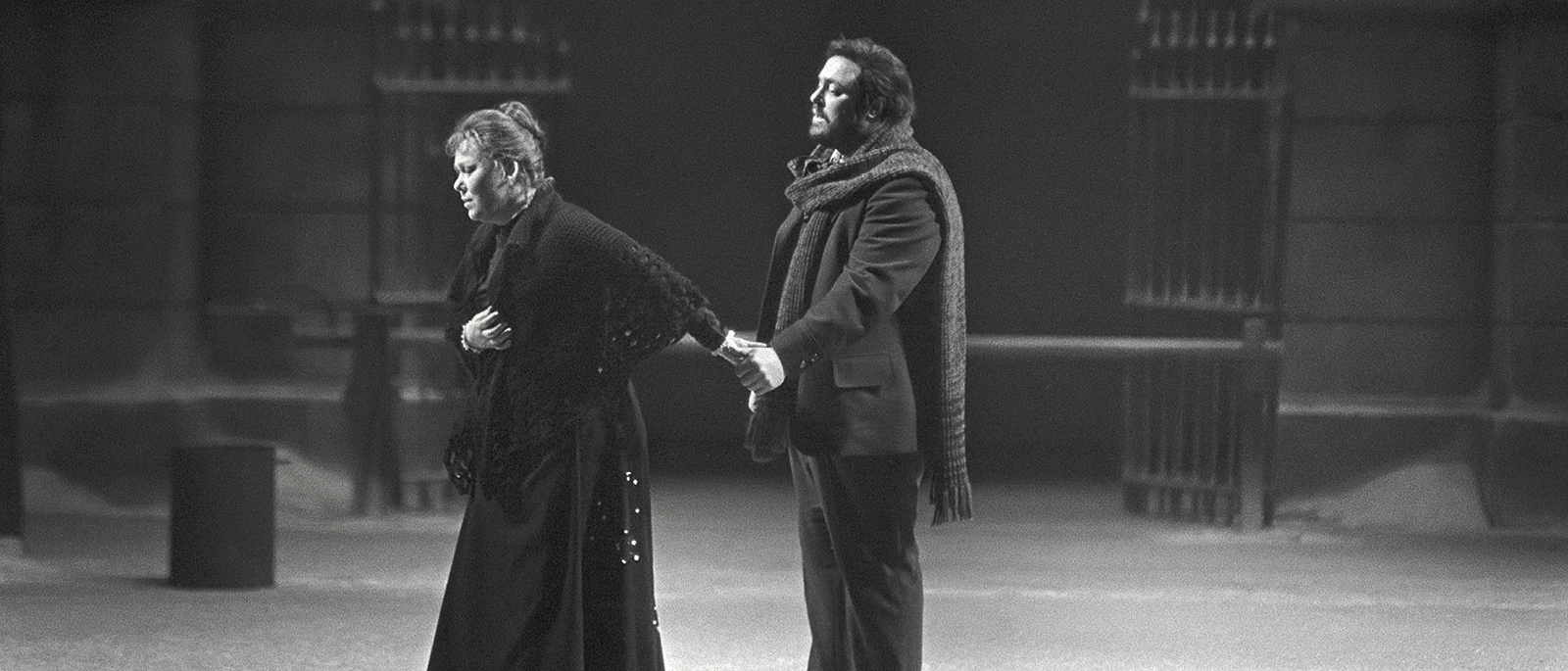
La Bohème
Considering that it is the most frequently staged opera in Met history (1,373 performances as of June 2023), La Bohème has had very few productions—just four, including its 1900 premiere. Initially received somewhat coldly by critics, it was nevertheless met with immediate public success and was performed in every Met season from 1900 to 1959.
The first completely new production of La Bohème after its company premiere came in the 1952–53 season, when it was sung in English in a staging by film director Joseph Mankiewicz. In 1977, it was the first opera to be telecast as part of the regular series of Met performances on PBS. Since 1981, Franco Zeffirelli’s picturesque production has reigned, and with more than 500 performances to date, its popularity has played a major role in La Bohème surpassing Verdi’s Aida as the Met’s most performed opera.
Left: The Met’s first Mimì was the legendary coloratura soprano Nellie Melba, who felt that the role didn’t offer her devotees enough of her fabled vocalism, so after the curtain came down on La Bohème, she returned to the stage and sang the mad scene from Donizetti’s Lucia di Lammermoor.
Photo: Ernest Walter Histed
Right: La Bohème premiere program, November 9, 1900.
Left: The role of Rodolfo has long been a favorite of tenors, such as the great Enrico Caruso, who holds the record for the most Met performances at 55. Caruso sang Rodolfo in 1903, during his first season with the company.
Photo: Herman Mishkin
Right: Enrico Caruso was the Met’s most valuable vocal asset from his debut in 1903 until his tragic early death in 1921. His contract for the three seasons from 1911 to 1914 provided for a fee of $2,000 per performance, the highest for any singer at the time. He was an exclusive Met artist in the United States and could only sing elsewhere in the country with the Met’s consent, except for his important gramophone recording sessions. Caruso was the first artist to sell one million records, and his discs made him a global celebrity. Caruso’s Met contract was issued in French, a common practice for European artists in the early 20th century.
Act II set for La Bohème, 1907.
Photo: White Studios
Left: One of the finest lyric tenors of the 20th century, Jussi Björling made his Met debut as Rodolfo in La Bohème in 1938. The Swedish tenor sang 123 performances at the Met over a period of two decades.
Photo: Sedge LeBlang
Right: Bidú Sayão appeared as Mimì at the Met from 1937 until 1952. Her petite stature and soft-grained voice created a particularly vulnerable, delicate character, and one that the Brazilian soprano would perform more than any other.
Photo: Wide World Studio
Act III set for La Bohème, 1951. This was the final year of the original production, which had played for more than half a century.
Photo: Louis Mélançon
Joseph Mankiewicz’s 1952 production of La Bohème, initially sung in English, featured native New Yorkers tenor Richard Tucker and baritone Robert Merrill, shown here in their Act IV duet. The English-language experiment was short-lived. The original Italian text was used in some performances in the initial season and returned permanently thereafter.
Photo: Sedge LeBlang
The Met’s regular series of televised operas on PBS began in 1977 with La Bohème, starring soprano Renata Scotto and tenor Luciano Pavarotti in the leading roles. The production by Fabrizio Melano, designed by Pier Luigi Pizzi, was borrowed from Lyric Opera of Chicago.
Photo: James Heffernan
Renowned Italian soprano Mirella Freni made her Met debut in 1965 as Mimì and sang the role often, including for the debut of her hometown friend tenor Luciano Pavarotti in 1968. Freni and Pavarotti again teamed up for a legendary La Bohème in 1988, led by conductor Carlos Kleiber in his company debut.
Photo: Louis Mélançon
Sketch by Rolf Gérard of the Act I set for the 1952 La Bohème production.
Franco Zeffirelli’s production premiered to an ecstatic reception in December 1981. Above, the director is seen in rehearsal with soprano Teresa Stratas and tenor José Carreras.
Photo: James Heffernan
Franco Zeffirelli’s production of La Bohème has been revived nearly every season for more than 40 years. Above are Zeffirelli’s sketch of the set for Act IV and a photo of the actual set.
Photo: James Heffernan;wl
Korean soprano Hei-Kyung Hong, pictured here with tenor Richard Leech in his Met debut as Rodolfo, has sung the role of Mimì in Franco Zeffirelli’s production more than any other soprano, a total of 67 times.
Photo: Winnie Klotz
California-native soprano Angel Blue joined the Met in 2017 as Mimì in La Bohème and the following year sang Musetta, a role that had served as both her operatic debut at LA Opera in 2007 and her La Scala debut in 2015.
Photo: Marty Sohl
The popular Franco Zeffirelli production of La Bohème has featured many different casts since its 1981 premiere. American soprano Leona Mitchell and Hungarian tenor Dénes Gulyás sang the lead roles in the 1986 revival.
Photo: James Heffernan
Franco Zeffirelli’s evocative vision for Act III of La Bohème features the gently falling snow heard in the music and mentioned in the libretto. Soprano Ailyn Pérez and tenor Matthew Polenzani sang the romantic leading roles in 2019.
Photo: Evan Zimmerman
La Bohème